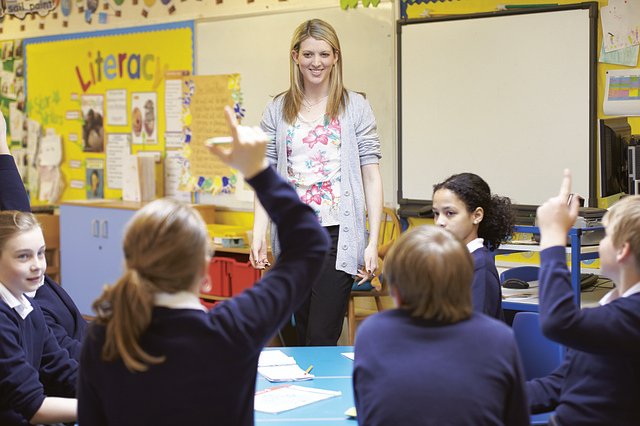Everything you do as an educator depends upon conversation, and those conversations influence students’ capacity to learn, teachers’ ability to be their best and administrators’ potential to achieve goals. The way we talk to ourselves and others affects everything; we need to be consciously intentional with our words.
Neuroscience and positive psychology have shown that positivity is essential for learning and growth. The prefrontal lobe and neocortex are the brain centers where cognitive functioning such as attention, creativity, critical thinking, planning, memory and relatedness take place. Barbara Fredrickson’s research shows that positive emotions — such as interest, curiosity, contentment, and hope — bathe the brain in biochemicals that broaden and build our capacity for relating, learning and higher-order thinking. The research clearly shows us the conditions students need to maximize their potential for learning.
How stress inhibits learning
Too often, a student’s environment generates the opposite. The global pandemic has ensured that most students and teachers spend their days in stressful environments; stress-hormones prime the brain for defense. Real or perceived threats to belonging, safety and security further stimulate the release of toxic biochemicals into the brain and body, preparing us to fight, freeze or flee. Those neurotransmitters inhibit access to the prefrontal lobe and neocortex; learning is eclipsed, and reactivity augments.
How many of your students swim in that sea of cortisol, testosterone and epinephrine on a daily basis? How many bring a fear-based mindset into the classroom from feeling unstable at home, being bullied in the hallway, feeling humiliated during PE or being rejected by other students?
Sometimes, without intention, a sharp look from the teacher, a critical comment or a well-intentioned admonition pushes those students farther away from their potential, making it even harder for them to listen, comprehend and think clearly. They struggle or fail not because they don’t want to learn, but because neurophysiologically, they can’t.
2 simple communication practices
Educators have one of the most powerful tools for shifting this trajectory: our conversations. We can change the biochemistry of our brain and someone else’s by intentionally engaging in conversations worth having with them. Only two simple practices are needed:
- Ask generative questions. These are questions that change the way people think and feel. These questions:
- Make the invisible visible, e.g.,“What strengths are you bringing to this project?”
- Create shared understanding, e.g., “How do you see it?” “How do you best learn?”
- Generate new knowledge, e.g., “What would be meaningful for you?”
- Inspire possibilities, e.g., “What if you could double the number of answers you got right?”
Such questions inspire new imagery and actions for students to consider.
- Positive framing. This means:
- Talking about what you and your students want instead of what you don’t want.
- Changing your approach to problems. Instead of trying to fix them, flip your focus to talk about the desired outcome and how to achieve it.
- Shifting your focus. Rather than honing in on a student’s negative behavior, take note instead of their appropriate behavior and acknowledge them for it. Talk with them about what you value about them and their contributions.
Tune in to be intentional
A conscious choice to select words and a focus that promises to increase positivity, productivity, and engagement allow you to use these practices most effectively. This can be difficult if you have students in your classroom who challenge your authority, never seem to engage or trigger negative reactions. If you’re not tuned in, that can result in comments that are likely to judge, criticize or shame, further shutting down a student’s learning ability and potential.
Tuning in expands your awareness and primes you to deliberately choose your words. Here’s a simple technique to try:
- Pause.
- Take a deep breath. Deep breathing activates your parasympathetic nervous system, reducing stress, widening your vision and boosting your ability to think critically, be creative and act choicefully.
- Get curious. Expand your awareness by asking yourself questions such as, “What’s my highest hope for this student?” “What don’t I know?” “What do I need in this moment?” If appropriate, you also can ask the student such questions as, “What’s really going on for you?” “Did you have breakfast this morning?” “How might you use your leadership strengths in positive ways?”
Education is one of the most important professions, and educators wield a powerful tool: their conversations. Use your words to have conversations worth having, which will maximize any student’s potential for learning.
Cheri Torres is CEO and lead catalyst of Collaborative by Design, a consulting firm that helps organizations improve performance, retain talent, and transform communication and culture. Torres has more than 35 years of leadership, teamwork, strategic planning and culture transformation experience. You can reach her on LinkedIn, Twitter and Instagram.
Jackie Stavros is management professor at the College of Business and Information Technology, Lawrence Technological University, and an Appreciative Inquiry advisor at the David L. Cooperrider Center for Appreciative Inquiry. Stavros has more than 30 years of leadership, strategic planning, and change management experience. You can reach her on LinkedIn, Twitter and Instagram.
Stavros and Torres have been researching, writing, consulting, and speaking on Appreciative Inquiry since 1996 and are co-authors of Conversations Worth Having: Using Appreciative Inquiry to Fuel Productive and Meaningful Engagement. To learn more about using generative questions, positive framing, and tuning in, download a free Conversation Toolkit with a list of questions for educators.
________________________________
Like this article? Sign up for our EdTech news briefing to get news like this in your inbox, or check out all of SmartBrief’s education newsletters, covering career and technical education, educational leadership, math education and more.
More from SmartBrief Education:
